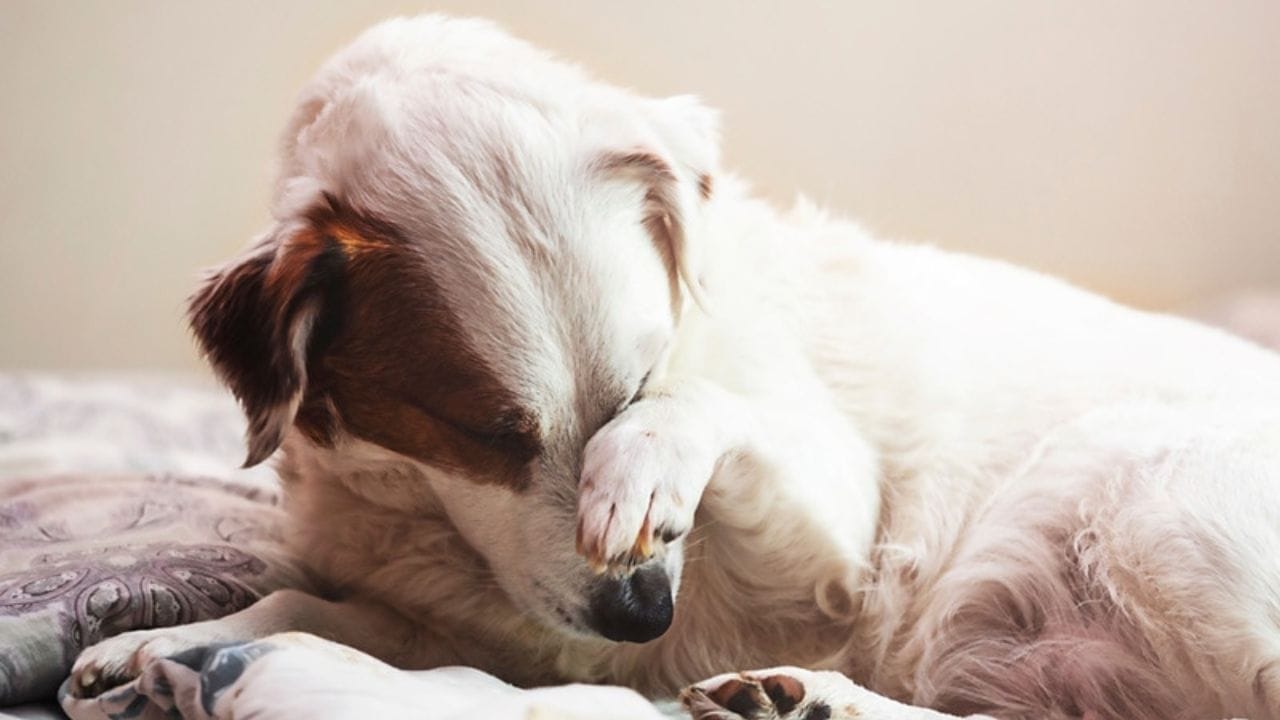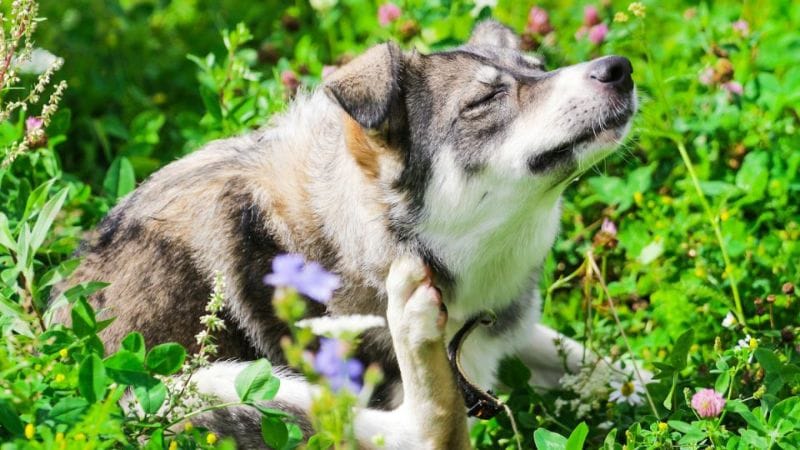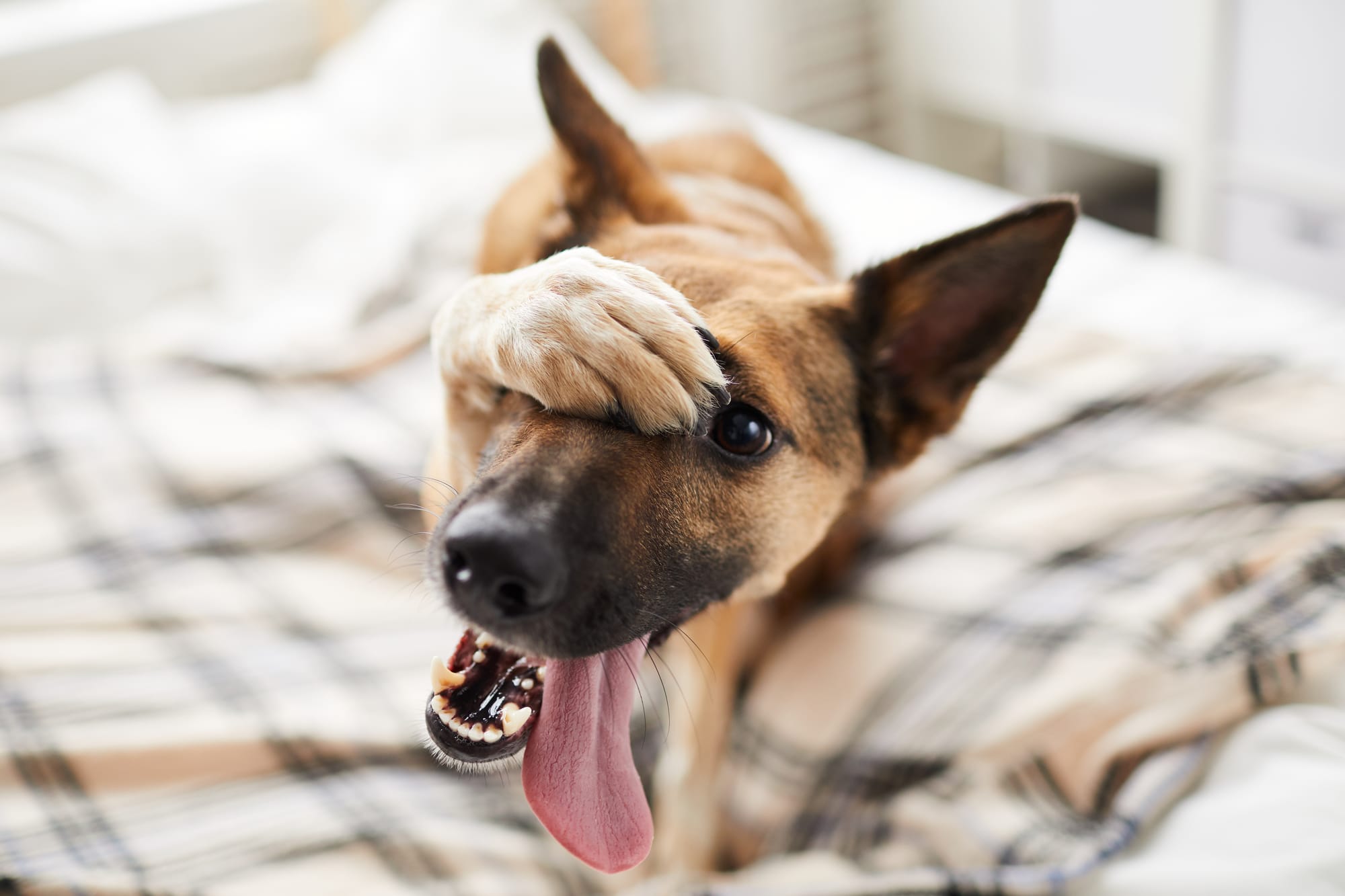Dogs are fascinating creatures that have been domesticated for thousands of years. They are known for their loyalty, affection, and playful nature. However, sometimes they exhibit strange behaviors that can leave their owners puzzled. One such behavior is when dogs cover their eyes with their paws or snouts. This article will explore the reasons why dogs do this, and what it means.

Dogs cover their eyes for a variety of reasons. One of the most common reasons is that they are feeling anxious or stressed. Covering their eyes can help them feel more secure and protected, as it blocks out some of the stimuli that may be causing them distress. Additionally, dogs may cover their eyes when they are feeling tired or sleepy. This is similar to how humans may cover their eyes with their hands when they are feeling drowsy.
Understanding why dogs cover their eyes can provide insight into their behavior and emotions. By recognizing the signs of anxiety or stress, pet owners can take steps to help their dogs feel more comfortable and secure. Additionally, knowing when their dog is feeling tired can help owners schedule appropriate rest and relaxation time. Overall, this behavior is just one of the many fascinating aspects of canine behavior that makes them such beloved companions.
Understanding Canine Body Language
Dogs communicate through body language, which can be a mix of postures, facial expressions, and vocalizations. Understanding canine body language can help dog owners interpret their pet's behavior and prevent misunderstandings.
Communication Through Body Postures
Dogs use their body to communicate their intentions and emotions. A dog's posture can convey confidence, fear, aggression, or submission. For example, a dog standing tall with its tail up and ears forward is usually confident and alert, while a dog cowering with its tail between its legs and ears back is showing fear.
Signs of Submission and Dominance
Dogs have a pack hierarchy, and they use body language to establish their position in the group. A dominant dog will usually stand tall with its ears forward, tail up, and hackles raised, while a submissive dog will crouch with its ears back, tail down, and may even roll over onto its back to expose its belly.
Emotional Responses and Behaviors
Dogs can display a range of emotional responses and behaviors. For example, a dog may wag its tail when happy or excited, growl when feeling threatened, or bark when trying to get attention. Dogs may also display submissive behaviors, such as licking their owner's face or rolling over onto their back.
By understanding canine body language, dog owners can better communicate with their pets and prevent misunderstandings. It is important to note that every dog is different, and it is essential to learn your pet's unique body language to understand their emotions and needs.

Common Reasons Dogs Cover Their Eyes
Dogs have a variety of behaviors that can be puzzling to their owners. One such behavior is when a dog covers their eyes with their paws or snout. Here are some common reasons why dogs exhibit this behavior.
Scratching an Itch
One reason why a dog may cover their eyes is to scratch an itch. Dogs may use their paws to scratch their eyes or the area around their eyes. This could be due to an irritation or allergy that is causing discomfort. If a dog is repeatedly scratching their eyes, it may be a good idea to take them to the vet to rule out any underlying medical issues.
Shielding Eyes from Light
Dogs may also cover their eyes to shield them from bright light. Just like humans, dogs can be sensitive to light, especially when it is too bright. If a dog is covering their eyes when they are outside or in a bright room, it may be a sign that the light is too intense for them. Providing a shaded area or using curtains to block out light can help alleviate this behavior.
Expressing Discomfort or Anxiety
Dogs may also cover their eyes when they are feeling uncomfortable or anxious. This behavior can be a way for a dog to self-soothe and feel more secure. If a dog is covering their eyes frequently or in situations that are causing stress or anxiety, it may be a sign that they need more support. Providing a safe space for the dog to retreat to, using calming aids such as pheromone sprays or supplements, or seeking the help of a professional dog trainer or behaviorist can all be helpful in reducing anxiety and stress in dogs.
In conclusion, dogs may cover their eyes for a variety of reasons. It is important for pet owners to be aware of their dog's behavior and to address any underlying issues that may be causing discomfort or anxiety. By providing a safe and comfortable environment for their furry friend, owners can help ensure that their dog is happy and healthy.
Health-Related Causes
Dogs may cover their eyes for a variety of reasons, including health-related causes. Here are some possible explanations:
Eye Infections and Inflammation
If a dog's eyes are red, swollen, or appear to be producing more gunk than usual, they may be experiencing an eye infection or inflammation. This can be caused by bacteria, viruses, or other irritants. In some cases, the dog may cover their eyes as a way to protect them from further irritation or infection.
Allergies and Irritants
Dogs can be allergic to a variety of things, including pollen, dust, and certain foods. When a dog is exposed to an allergen, their eyes may become itchy, red, and swollen. In some cases, the dog may cover their eyes as a way to alleviate the discomfort caused by the allergy.

Pain and Discomfort Indicators
Dogs may also cover their eyes if they are experiencing pain or discomfort. This can be caused by a variety of factors, such as an injury, a foreign object in the eye, or a more serious condition such as glaucoma. If a dog is covering their eyes frequently or for prolonged periods of time, it may be a sign that they are in pain and should be taken to the vet for a check-up.
Overall, if a dog is covering their eyes frequently or for prolonged periods of time, it is important to take them to the vet to rule out any underlying health issues.
Behavioral and Psychological Factors
Dogs are complex creatures, and their behavior can be influenced by a variety of factors. Here are some possible explanations for why dogs may cover their eyes:
Fear, Anxiety, and Stress
Dogs may cover their eyes as a way to cope with fear, anxiety, or stress. These emotions can be triggered by a variety of factors, such as loud noises, unfamiliar surroundings, or the presence of other animals. By covering their eyes, dogs may be trying to block out some of the stimuli that are causing them distress.
Seeking Attention or Affection
Dogs are social animals, and they crave attention and affection from their owners. Some dogs may cover their eyes as a way to get their owners to pay attention to them. By covering their eyes, dogs may be trying to elicit a response from their owners, such as a pat on the head or a scratch behind the ears.
Response to Being Scolded
Dogs are sensitive creatures, and they can be deeply affected by negative feedback from their owners. If a dog has been scolded or reprimanded, they may cover their eyes as a way to avoid eye contact with their owner. This behavior may be a sign of embarrassment or shame.
Overall, there are many possible explanations for why dogs may cover their eyes. By understanding these behaviors, dog owners can provide their pets with the care and attention they need to live happy and healthy lives.

Interpreting Dog's Actions
Dogs have their unique ways of communicating with their owners and other animals. Interpreting their actions can be challenging, but it is essential to understand their behavior to ensure their well-being. In this section, we will discuss some of the common actions of dogs and what they might mean.
Grooming Behaviors
Dogs are known to be fastidious animals that spend a significant amount of time grooming themselves. Grooming is a way for dogs to keep themselves clean, healthy, and comfortable. Paw licking is one of the most common grooming behaviors in dogs. It is a way for them to clean their paws and remove any debris that might be stuck between their toes. Dogs also use their paws to wipe their faces to clean their eyes and mouth.
Avoiding Eye Contact
Dogs use eye contact to communicate with their owners and other animals. However, sometimes, they might avoid eye contact. Avoiding eye contact can be a sign of submission or fear. If a dog is afraid or feels threatened, they might avoid eye contact to show that they are not a threat. It is essential to be patient and give the dog some space to calm down.
Use of Paws in Communication
Dogs use their paws to communicate with their owners and other animals. For example, if a dog wants attention, they might paw at their owner's leg or jump up to get their attention. If a dog is feeling anxious or stressed, they might paw at their face or cover their eyes to block out any stimuli that might be causing them distress.
In conclusion, understanding a dog's behavior can be challenging, but it is essential to ensure their well-being. Grooming behaviors, eye contact, and the use of paws in communication are just a few of the ways dogs communicate with their owners and other animals. By paying attention to these behaviors, owners can better understand their furry friends and provide them with the care they need.
Influences on Canine Behavior
Pack Dynamics and Leadership
Dogs are pack animals and have a natural tendency to follow a pack leader. In the wild, the pack leader is responsible for making decisions that ensure the survival of the pack. This instinctual behavior is still present in domesticated dogs, and they look to their human owners as their pack leader.
The concept of dominance has been widely debated in the dog training community. Some believe that establishing dominance is necessary to maintain control over a dog, while others argue that it can lead to aggressive behavior. It is important to note that dominance should not be confused with aggression.

Environmental and Situational Triggers
Environmental and situational triggers can also influence canine behavior. Stressful situations such as loud noises, unfamiliar environments, and changes in routine can cause dogs to exhibit anxious behavior. Dogs may also cover their eyes as a way to cope with stress or to avoid eye contact with a perceived threat.
Pack hierarchy can also play a role in a dog's behavior. Dogs may cover their eyes as a submissive gesture to show respect to a higher-ranking pack member. Similarly, dogs may cover their eyes when they are unsure of their place in the pack hierarchy and do not want to challenge a higher-ranking member.
In conclusion, a dog's behavior is influenced by a variety of factors, including pack dynamics, environmental triggers, and situational triggers. Understanding these factors can help dog owners better understand their pet's behavior and provide appropriate training and care.
Managing and Addressing the Behavior
Dogs covering their eyes can be a sign of discomfort or anxiety, and it is important for pet owners to manage and address this behavior appropriately. Here are some ways to do so:
When to Consult a Veterinarian
If a dog's eye covering behavior is sudden or excessive, it may be a sign of an underlying medical condition. In such cases, it is important to consult a veterinarian to rule out any health issues. A vet can also provide guidance on managing the behavior.
Training and Positive Reinforcement
Training and positive reinforcement can be effective in managing a dog's eye covering behavior. For example, teaching a dog to associate a particular command with a positive experience can help to distract them from the behavior. Similarly, rewarding a dog for not engaging in the behavior can help to discourage it.
Creating a Comfortable Environment
Creating a comfortable and safe environment for a dog can also help to reduce eye covering behavior. This can include providing a comfortable bed, toys, and other items that the dog enjoys. Additionally, reducing exposure to stressful situations or stimuli can also be helpful.
Overall, it is important for pet owners to be patient and consistent when addressing a dog's eye covering behavior. With the right approach, it is possible to discourage negative behavior and create a comfortable and positive environment for the pet.
Conclusion
In conclusion, dogs cover their eyes for a variety of reasons. It is a behavior that is observed in many canine companions, and it is important for dog owners to understand why their pets do this. Dogs may cover their eyes as a way of communicating their emotions, such as anxiety, fear, or stress. It may also be a sign that they are feeling tired or need some rest.
Caring for dogs involves understanding their behavior and communication, and being able to recognize when they are feeling uncomfortable or distressed. By paying attention to their body language and behavior, dog owners can better understand their pets and provide them with the care they need.
Overall, there is still much to learn about why dogs cover their eyes, but by observing their behavior and paying attention to their needs, we can provide them with the best possible care and ensure that they are happy and healthy.
FAQs
- Why do dogs cover their eyes with their paws or snouts?
- Dogs might cover their eyes for various reasons, including feeling anxious or stressed, being exposed to bright light, experiencing discomfort due to an itch or irritation, or as a self-soothing behavior when they're feeling tired or sleepy.
- Can covering their eyes indicate a health problem in dogs?
- Yes, if a dog frequently covers their eyes or does so with excessive force, it could indicate health issues such as eye infections, inflammation, allergies, or even pain from a foreign object in the eye or other serious conditions. Consulting a veterinarian is recommended to rule out any underlying health problems.
- How can understanding a dog's body language improve our relationship with them?
- Understanding canine body language, including postures, facial expressions, and vocalizations, helps dog owners interpret their pet's feelings and intentions. This can prevent misunderstandings and foster a deeper bond by responding appropriately to the dog's needs and emotions.
- What does it mean when a dog avoids eye contact?
- Avoiding eye contact can be a sign of submission or fear in dogs. It may indicate that the dog feels threatened or wants to show they are not a threat. Recognizing this behavior can help owners provide reassurance or space to their pets as needed.
- How do environmental factors affect a dog's behavior?
- Environmental and situational triggers such as loud noises, unfamiliar surroundings, and changes in routine can lead to anxious behaviors in dogs. Understanding these influences can help owners create a more comfortable environment for their pets and manage their reactions to stress.
- What should I do if my dog covers their eyes frequently?
- If a dog covers their eyes often, it's essential to observe the context and other symptoms to determine the cause. If it seems related to discomfort, stress, or health issues, consulting a vet or a professional dog behaviorist may be necessary to address the underlying problem.
- How can I help my dog if they're covering their eyes due to anxiety or stress?
- Providing a safe and quiet space for your dog to retreat, using calming aids like pheromone diffusers, and maintaining a routine can help reduce anxiety. Positive reinforcement training can also encourage more confident behaviors. If the issue persists, seeking advice from a professional behaviorist could be beneficial.




